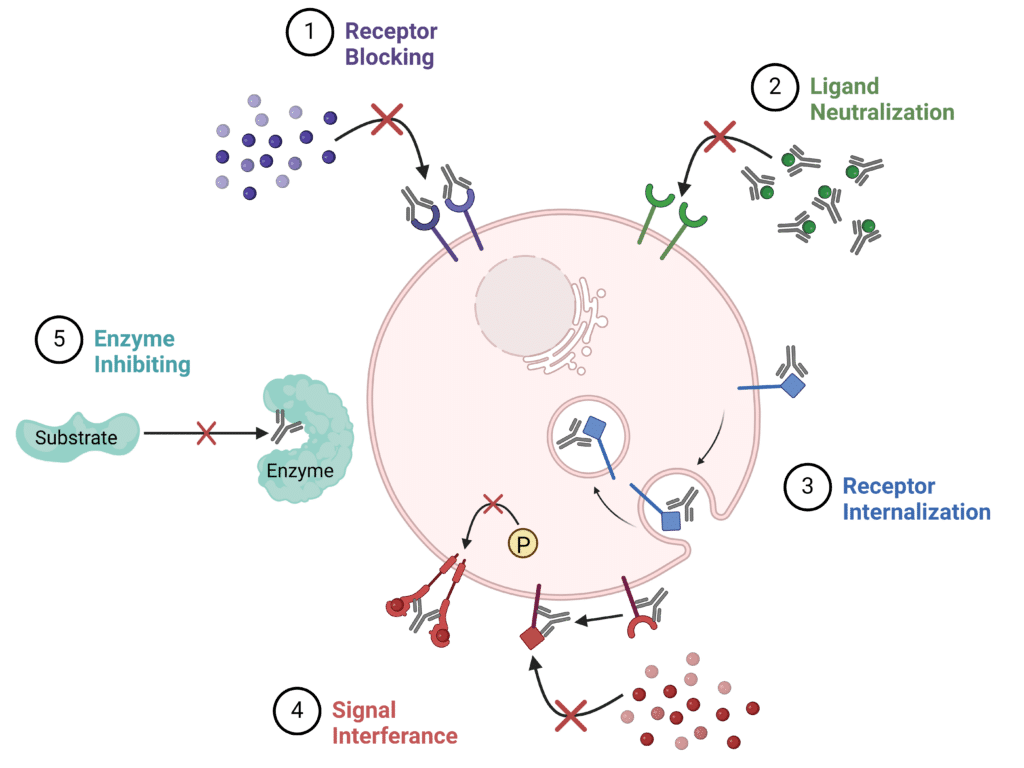 Written by: Jenna Kerry, MSc
Written by: Jenna Kerry, MSc
Published: August 14, 2024
What are Antagonistic Antibodies?
Antagonistic antibodies are a monoclonal antibody that bind to and inhibit the function of their target molecules, often receptors or ligands. These antibodies are designed to block the interaction between the target molecule and its natural binding partner, thereby inhibiting the biological pathway of interest. As a result, antagonistic antibodies have become a game-changer in treating diseases such as cancer, autoimmune disorders, and chronic inflammatory conditions. Regardless of the opportunities they provide, antagonistic antibodies have a wide range of obstacles when it comes to their discovery and development.
How do Antagonistic Antibodies Work?
Antagonistic antibodies are designed to inhibit a specific biological pathway of interest. Based on the biological pathway of interest, the antagonistic antibodies can be designed to bind a receptor, ligand, antibody, or small molecule. The functions and characteristics of antagonistic antibodies can vary dramatically depending on the desired target and downstream results. There are many ways in which antagonistic antibodies can elicit their effects (Figure 1):
- Receptor Blocking: Antagonistic antibodies can be designed to act as a blocking mechanism by binding to a specific epitopes on receptors of interest, thereby preventing the ligand or molecule from binding and activating the receptor. For example, trastuzumab humanized anti-HER2 antibody binds to the HER2 receptor and blocks receptor activation.
- Ligand Neutralization: Antagonistic antibodies can also inhibit biological pathways by binding to soluble ligands. The ligands are thus prevented from binding their target receptors, which neutralizes the biological activity. For example, adalimumab antibodies bind to tumor necrosis factor (TNF)-alpha thereby neutralizing the ligand and inhibiting its function in inflammation.
- Receptor Degradation: Antagonistic antibodies can be designed to bind to an epitope that triggers internalization and degradation of the receptor of interest, which halts the biological pathway associated with the receptor of interest. For example, daratumumab targets multiple myeloma cells and triggers the internalization and degradation of the CD38 receptor.
- Signal Interference: Antagonistic antibodies can interfere with signal cascades in two different ways, namely blocking dimerization or allosteric inhibition. For blocking dimerization the antagonistic antibody binds to an epitope that inhibits receptor dimerization and subsequent activation and signal cascades. In terms of allosteric inhibition, the antagonistic antibody binds to an epitope that leads to a conformational change of the receptor of interest leading to it being “turned off”. For example, cetuximab binds to the extracellular domain of epidermal growth factor receptor (EGFR) and prevents dimerization and activation.
- Inhibiting Enzymes: Antagonistic antibodies can bind to and inhibit enzyme function, switching off a specific biological pathway. For example, alirocumab binds to and inhibits the enzyme proprotein convertase subtilisin/kexin type 9 (PCSK9) which increases the clearance of cholesterol from the bloodstream.
Figure 1: Antagonistic Antibodies Mechanisms of Action.
Antagonistic Antibody Opportunities
Antibody therapy has become a cornerstone of modern medicine due to its specificity, versatility, and effectiveness in treating a wide range of diseases. Antagonistic antibodies are ideal for treating autoimmune diseases, infectious diseases, and conditions where inhibiting signaling pathways is necessary. Here are several scenarios where antagonistic antibodies provide therapeutic opportunities and would be the optimal choice:
Cancer Therapeutics
In cancer therapeutics, antagonistic antibodies are optimal for treating cancers driven by growth factors. One notable example is cancer caused by a mutation in the human epidermal growth factor receptor 2 (HER2), where the receptor’s constant activation leads to uncontrolled cell proliferation. Antagonistic antibodies like trastuzumab are effective for this type of cancer as they can inhibit the function of HER2.
Additionally, antagonistic antibodies such as bevacizumab can be used to treat various cancers by inhibiting vascular endothelial growth factor (VEGF). This inhibition prevents angiogenesis, thereby cutting off the blood supply to the tumor. Furthermore, antagonistic antibodies like pembrolizumab can block biological pathways that reduce immune function, thereby enhancing the immune system’s ability to attack cancer cells. This method of enhancing the immune system is preferable to using agonistic antibodies because it selectively prevents cancer cells from evading immune detection without broadly activating immune cells. This targeted approach reduces the risk of severe immune-related adverse events.
Autoimmune Disease
Antagonistic antibodies provide a controlled modulation of the immune system. By blocking specific targets, they can dampen excessive immune responses without broadly stimulating the immune system, which is particularly important in conditions where immunosuppression is desired, such as in autoimmune diseases. For example, adalimumab and infliximab can both be used to inhibit TNF-alpha to reduce inflammation and tissue damage when treating rheumatoid arthritis, psoriasis, and Crohn’s disease.
Infectious Disease
Infectious diseases are best treated with antagonistic antibody therapy since the antibodies can effectively bind and neutralize the pathogen without triggering excessive immune response. The antibodies can bind and inhibit pathogen proteins or toxins thereby prohibiting disease progression without the negative side effects of over stimulating the immune system. For example, palivizumab, an antagonistic antibody, is used to treat respiratory syncytial virus (RSV) by binding to the RSV F protein, preventing the virus from entering host cells and replicating. Another example is the treatment of bacterial infections caused by Clostridium difficile. Antagonistic antibodies like bezlotoxumab are designed to neutralize the toxins produced by the bacteria, reducing the severity and recurrence of the infection.
Physiological and Genetic Diseases
In terms of physiological and genetic diseases, antagonistic antibodies provide great opportunity as therapeutic agents. Specifically, they can be used to target pathways of disease pathology and reduce or alleviate symptoms of disease in a precise and effective manner.
In genetic diseases, antagonistic antibodies can be used to target the defective proteins responsible for the disease. For instance, in familial hypercholesterolemia the antagonistic antibody evolocumab can be used to inhibit PCSK9 which is a protein that reduces the liver’s ability to remove LDL cholesterol from the blood. By inhibiting PCSK9, the LDL cholesterol can more effectively be removed from the blood thereby reducing disease symptoms.
In physiological diseases, antagonistic antibodies are currently at the forefront of research for improving therapeutics. For example, ongoing research is being done to create an antagonistic antibody treatment for diseases like diabetes and Alzheimer’s disease. In diabetes, antagonistic antibodies targeting glucagon-like peptide 1 receptor (GLP-1R) are showing promising results for effective and improved treatment. In Alzheimer’s disease, studies have shown that antagonistic antibody lecanemab reduced markers of amyloid in early Alzheimer’s disease and improved symptoms.
Antagonistic Antibody Obstacles
Regardless of the vast opportunities they provide, antagonistic antibodies have certain obstacles present during the discovery and development stages:
- Specificity and Affinity: It is important to verify that the antagonistic antibody binds with high specificity and affinity to the target antigen without cross-reacting with other proteins.
- Target Antigen Conformation: Purifying and expressing the antigen in its native conformation is difficult, especially for trans-membrane receptors, which are often the targets for antagonistic antibodies. This complicates the discovery and subsequent development of effective antibodies.
- Biological Activity Confirmation: Confirming that the antagonistic antibody not only binds effectively to the antigen of interest, but also inhibits the intended biological pathway. This may only be possible with cell based assays.
- Immune Response Modulation: The antagonistic antibodies must not be recognized by the human immune system as this can drive an immune response against them, leading to the production of anti-drug antibodies (ADAs) which can neutralize the therapeutic effects and cause adverse reactions.
- Engineering Considerations: Engineering antagonistic antibodies to be humanized or expressed in advanced formats (bispecific, Fab, ADC, etc.) while maintaining function and potency is challenging. For instance, humanizing murine antibodies to reduce immunogenicity can affect binding efficiency and stability.
- Epitope Selection: This requires extensive research into the biological pathway, structure, and function of the antigen. Identifying and validating the precise epitopes on the antigen to ensure effective inhibition without off-target effects.
- Behaviour In vivo: Confirming the antagonistic antibody has favorable properties, such as appropriate half-life, distribution, and clearance from the body is challenging. Understanding antibody behavior in the body, including distribution, metabolism, and excretion, is crucial for effective therapy development.
Antibody Discovery Platform for Antagonistic Antibodies
Discovering and developing antagonistic antibodies is a multifaceted process involving several innovative approaches to overcome the challenges mentioned above. Depending on your specific application needs, discovering and developing antagonistic antibodies can involve several strategies listed here.
Rapid Novor’s REpAb® antibody discovery services offers a cutting-edge service for identifying and developing high-affinity antagonistic antibodies. Utilizing advanced screening technologies, de novo antibody sequencing using mass spectrometry, and bioinformatics, we accelerate the discovery process.
Our comprehensive approach includes everything from antibody generation all the way to lead optimization, providing a high success rate and rapid turnaround time. Tailored solutions and expert support are provided for therapeutic development, research tools, and diagnostic applications. For more information, contact our scientists today.
Talk to Our Scientists.
We Have Sequenced 10,000+ Antibodies and We Are Eager to Help You.
Through next generation protein sequencing, Rapid Novor enables reliable discovery and development of novel reagents, diagnostics, and therapeutics. Thanks to our Next Generation Protein Sequencing and antibody discovery services, researchers have furthered thousands of projects, patented antibody therapeutics, and developed the first recombinant polyclonal antibody diagnostics.
Talk to Our Scientists.
We Have Sequenced 9000+ Antibodies and We Are Eager to Help You.
Through next generation protein sequencing, Rapid Novor enables timely and reliable discovery and development of novel reagents, diagnostics, and therapeutics. Thanks to our Next Generation Protein Sequencing and antibody discovery services, researchers have furthered thousands of projects, patented antibody therapeutics, and ran the first recombinant polyclonal antibody diagnostics


